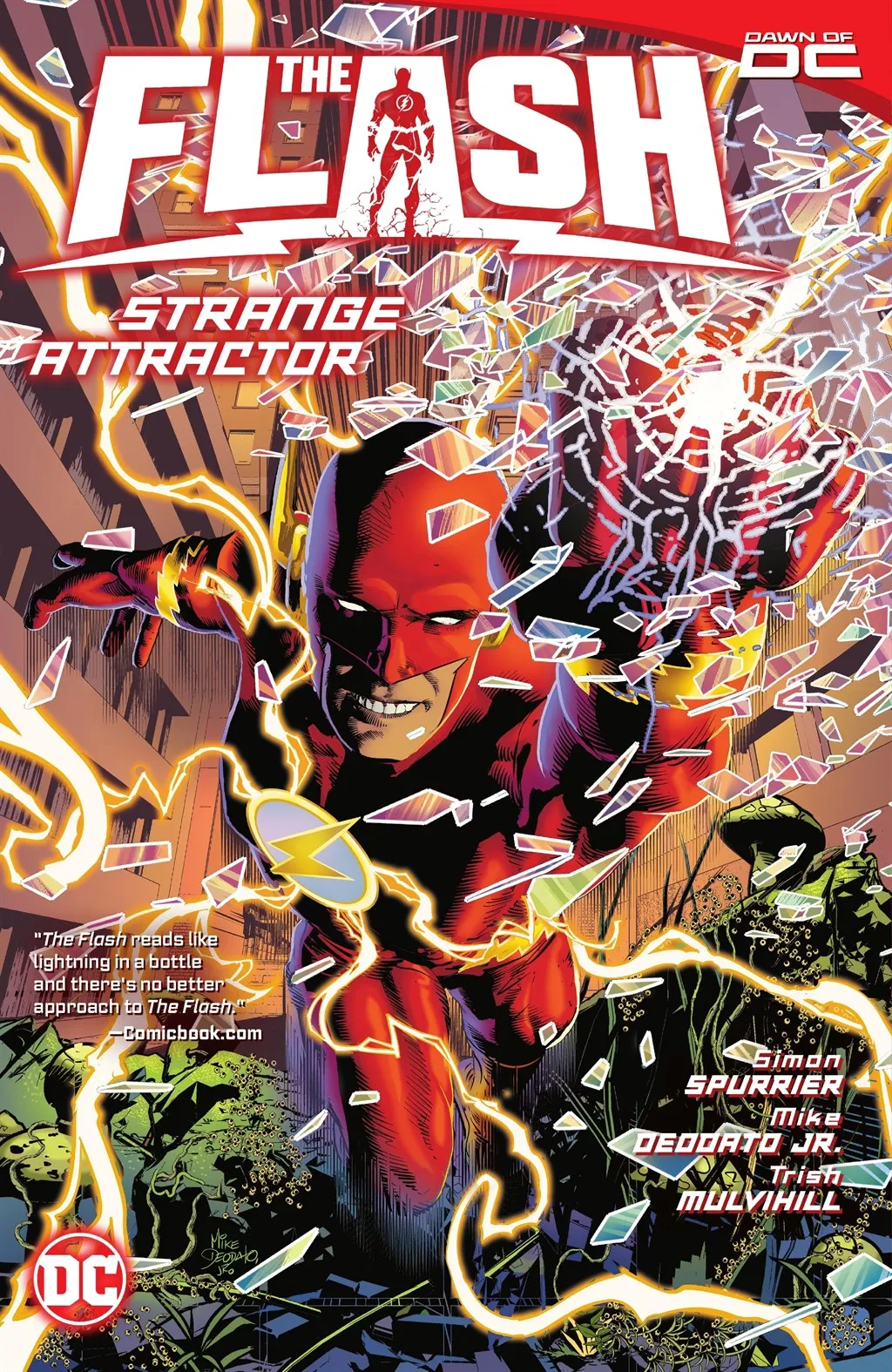The Flash has been synonymous with sci-fi comics certainly since the Silver Age, and Simon Spurrier’s ultra-out-there run beginning with Flash Vol. 1: Strange Attractor feels like a modern reimagining of that tradition. I was also impressed with how rooted Spurrier’s story is in Jeremy Adams' Flash Wally West run just previous, despite the change in tone from semi-standard superheroics to deeply weird science-fiction.
Mike Deodato’s art is what really sells it, with his increasingly bizarre, even grotesque alt-dimensional landscapes. It’s the kind of thing you want everyone to see because it looks so different from the popular imagination of what comics look like.
And yet, something feels off here.
In the first pages, Linda Park-West has demanded (unfairly) an evening where her husband doesn’t use his powers and Wally (wrongly) has been using his powers in front of Linda the whole time and pretending he hasn’t. It’s an introduction to protagonists who seem profoundly troubled and even, in Wally’s case, profoundly selfish. That extends to include much of the larger Flash family, and ends in a bad place — in which poor depictions of the Flashes manifest again, and with the very same plot reasons again.
With this, Flash Vol. 1: Strange Attractor becomes a book great to look at but not always so much fun to read, and with a repetitious storyline aborning that suggests an urgent need for new ideas in the Flash-verse.
[Review contains spoilers]
Jumping straight to the end, the final page revelation in Strange Attractor is that much of what plagues Wally here — rifts with his wife, his children, his mentor — seems to be manufactured to bring about the “Crown of Thawnes.” The suggestion there is that we’re within yet another plot by the Reverse Flash to emotionally manipulate the Flashes toward some end, just the same as we saw in Joshua Williamson’s Flash run and a variety of stories prior. I grant it’s hardly a Superman story without Lex Luthor, but this incessant return to Reverse Flash being the secret villain behind every Flash story has reached a level of annoyance that the Joker in Batman stories or Sinestro in Green Lantern stories simply hasn’t.
[See the latest DC trade solicitations.]
It remains to be seen exactly how much of everything is the Reverse Flash’s fault. In his early-post-Crisis youth, Flash Wally West was known for being uncourteous, so a revert to a certain amount of selfishness here isn’t out of character. However, the incessant suggestion that Wally’s doing too much and giving to everyone with taking time for himself does grate when leveled against that Linda’s home taking care of their newborn and their other kids are left to fend for themselves. Though I don’t disagree that the Wests' discombobulation may be normal given the arrival of a new baby, the chapter that darkly describes Linda’s severe emotionlessness is concerning indeed, and feels far from Mark Waid’s Linda hoisting a laser blaster against Kobra.
But Strange Attractor seems more explicit that the Reverse Flash’s plot does account for the changes in Flash Barry Allen. The book comes at this oddly sideways — when we first find Barry in the book, there’s talk that he’s “taking some time away” from his powers because he’s “gone through some stuff lately,” though what that refers to I’m not sure. But it’s later, in the otherwise-separate Titans: Beast World Tour: Central City issue, that we understand Barry’s been suffering from headaches and also there’s some distance, if not outright rivalry, between he and Wally. This culminates in the final-chapter argument where Wally says he’s worried and Barry offers this groan-worthy bon mot: “Sure. Worried enough to check in at least none times every week.”
Constant readers have heard me criticize Williamson’s “sad sack Barry Allen,” constantly miserable throughout that Flash run (also caused by the Reverse Flash, and maybe prolonged by DC’s shifting Doomsday Clock plans). As such, Barry shaken here again by outside influences also seems repetitive, with the added trouble that Spurrier writes Barry like a petulant child. In this same sequence, Barry and Wally have rarely looked better under Deodato’s pen as they race around a flowing spiked alien energy-thing, but what is a reader supposed to think of whiny Barry and self-centered Wally and put-upon Linda?
I did, again, appreciate that Spurrier continues a lot from Jeremy Adams' Flash — Wally working for Mr. Terrific amidst a group of scientists, Irey and Jai West and their friend Maxine “Animal Girl” Baker, references to Timepoint and Gold Beetle, Irey and Jesse Quick’s friendship. Spurrier would have been within his rights to jettison all of it in starting his new run, and I believe the harder path is the one Spurrier chose, to integrate what came before with what’s next. Spurrier writes Irey and Jai as kid-like but still more mature (and less annoying) than either Adams or Waid, and the sequences of their souped up powers are among the book’s best.
Flash Vol. 1: Strange Attractor looks great, and Simon Spurrier’s Stillness and Uncoiled and Arc Angels and the branepaths are buffeted by Mike Deodato’s distinct glowing god-creatures and tech-forward Grodd and the fleshy “animated homonculi.” But for all the science jargon in this book, Wally at times refers to himself as a “super-scientist imposter” and there’s much talk of no one understanding the Speed Force. I grant the Oan Central Power Battery’s been “reimagined” many times, but again this feels far from when Mark Waid’s Wally West was a Speed Force guru; the characters seem blithe and sloppy by design, and that’s not my favorite. The art will only balance it out for so long.
[Includes original and variant covers]

Comments
To post a comment, you may need to temporarily allow "cross-site tracking" in your browser of choice.